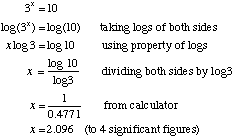Logarithms, shortened to logs, are indices with special base numbers.
These special numbers are usually either:
10 which produces common logarithms.
On calculators common logs are given by the button.
OR
e a special number, which produces natural logarithms.
On calculators natural logs are given by the button.
The exponential function y = ex is studied in more detail in Topic 24.
In the days before calculators and computers, tables of logarithms were used to carry out tedious numerical calculations such as long multiplication and division.
The basic definition of a logarithm is:
|
If ba = c then log bc = a
|
What it means is that for every index statement there is an equivalent logarithmic statement and
conversely
for every logarithmic statement there is an equivalent index statement.
e.g.
|
Index statement
|
Log statement
|
|
100 = 102
|
log 10100 = 2
|
|
81 = 34
|
log 381 = 4
|
|
32 = 25
|
log 232 = 5
|
|
9 = 32
|
log 39 = 2
|
|
The calculator buttons log and ln only find logs to base 10 and e respectively.
|
|
Properties of Logarithms
Logarithms, to any base, have three main properties.
|
Property
|
Description
|
Example
|
|
log (ab) = log a + log b |
The log of two terms being multiplied together equals the sumof the logs of the two terms. |
Simplify log 4 + log 5 |
| log a⁄b = log a − log b | The log of two terms being divided equals the difference of the logs of the two terms | Simplify log 64 − log 16 = log 64/16 = log 4 |
| log an = n log a | The log of a number to a power equals the log of the number multiplied by the power, |
Write 3 log 5 as the log of a single number 3 log 5 = log 53 = log 125 |
| log a a = 1 | The log of a number with the same base equals 1. | log10 10 = 1 this is because 101 = 10 |
| log a 1 = 0 | The log of 1 to any base is 0 | log 10 1 = 0 |
Using logs to solve index or exponential equations
Simple index equations such as 4x = 64 can be solved using the properties of exponents.
4x = 64
4x = 43
Therefore x = 3
Logarithms can be used to solve more complex equations involving indices, which are not able to be solved using other methods.
e.g. 3x = 10. (There is no conventional way to solve this equation.)
The method used is to "take logs" of both sides of the equation.

Two more difficult examples:
| Example 1 | Example 2 |
|
3x = 10.2x (remember the "." means multiply) |
2.33x+2 = 50 (remember the "." means multiply) |